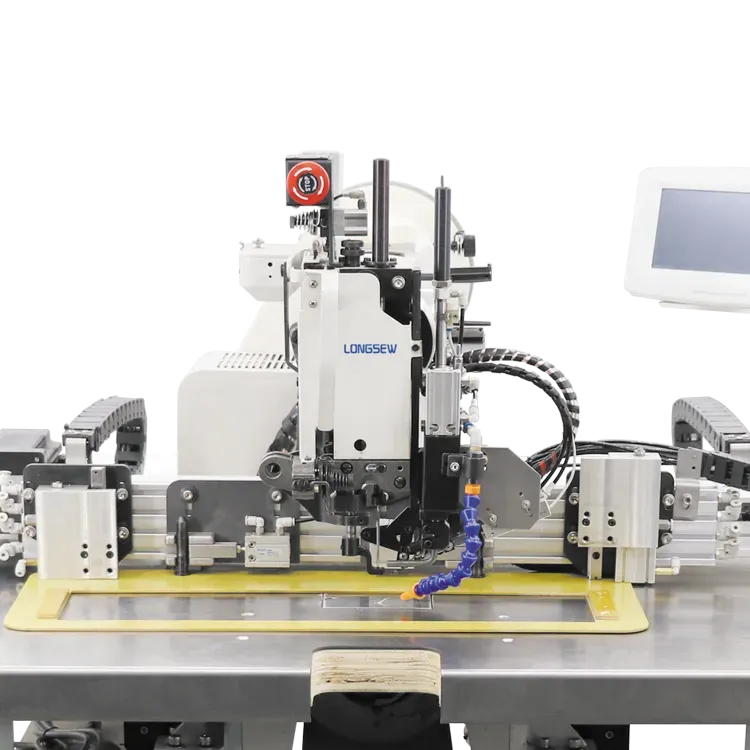Feb . 13, 2025 17:27
Back to list
Long Arm Heavy Duty Cylinder Bed Horizontal Direction Sewing Machine For Like Boot Long Barrel Products GA411N
Sewing leather on a home sewing machine might seem like a daunting task, but with the right approach and tools, it can be a rewarding experience that expands your crafting skills and project possibilities. Through firsthand experience, professional insights, and a steadfast commitment to achieving high-quality results, this guide provides a detailed walkthrough for sewing leather at home, ensuring a smooth process from start to finish.
3. Sewing Speed Leather needs a steady speed. Go slower than usual to ensure precision and prevent overheating the needle or breaking the thread. 4. Stitching Techniques Backstitching at the beginning and end of your seams often isn't recommended, as it can create unnecessary holes. Instead, leave long tails and tie them for a cleaner finish. Expert Recommendations For those looking to venture into more intensive leather sewing or frequent projects, consider - Specialized Machines While a home machine is sufficient for small projects, a walking foot industrial machine is preferable for more significant tasks, offering stronger feed and stitch quality. - Leather Conditioner Applying conditioner after sewing enriches the leather, making it supple and more robust, projecting a professional finish. - Professional Guidance Engaging in workshops or tutorials from leather experts can offer insider tips and broaden your perspective on advanced projects. Safety and Maintenance Leather sewing does exert more pressure on your machinery. Regularly clean the machine, particularly near the feed dogs and bobbin area, where fibers might accumulate. Lubricate as needed per your machine's manual, ensuring sustained efficiency over time. Developing Aesthetic and Functional Products Sewing leather empowers you to design unique, customizable pieces—from wallets and belts to intricate fashion accessories. Pay attention to aesthetics such as edge finishes, stitch colors, and embossed details. Moreover, commit to producing high-functionality products by reinforcing stress points with riveting or using hybrid fabric-leather designs for flexibility. Conclusion With the guidance outlined, sewing leather at home transcends from a challenging endeavor into a rewarding process. By building skills progressively, acquiring the necessary equipment, and embracing a patient trial-and-error approach, crafting with leather becomes yet another creative outlet for detailed, personalized projects.


3. Sewing Speed Leather needs a steady speed. Go slower than usual to ensure precision and prevent overheating the needle or breaking the thread. 4. Stitching Techniques Backstitching at the beginning and end of your seams often isn't recommended, as it can create unnecessary holes. Instead, leave long tails and tie them for a cleaner finish. Expert Recommendations For those looking to venture into more intensive leather sewing or frequent projects, consider - Specialized Machines While a home machine is sufficient for small projects, a walking foot industrial machine is preferable for more significant tasks, offering stronger feed and stitch quality. - Leather Conditioner Applying conditioner after sewing enriches the leather, making it supple and more robust, projecting a professional finish. - Professional Guidance Engaging in workshops or tutorials from leather experts can offer insider tips and broaden your perspective on advanced projects. Safety and Maintenance Leather sewing does exert more pressure on your machinery. Regularly clean the machine, particularly near the feed dogs and bobbin area, where fibers might accumulate. Lubricate as needed per your machine's manual, ensuring sustained efficiency over time. Developing Aesthetic and Functional Products Sewing leather empowers you to design unique, customizable pieces—from wallets and belts to intricate fashion accessories. Pay attention to aesthetics such as edge finishes, stitch colors, and embossed details. Moreover, commit to producing high-functionality products by reinforcing stress points with riveting or using hybrid fabric-leather designs for flexibility. Conclusion With the guidance outlined, sewing leather at home transcends from a challenging endeavor into a rewarding process. By building skills progressively, acquiring the necessary equipment, and embracing a patient trial-and-error approach, crafting with leather becomes yet another creative outlet for detailed, personalized projects.
Latest news
-
Boost Production Efficiency with a Pattern Sewing MachineNewsAug.29,2025
-
Industrial Excellence with the Best Heavy Duty Sewing MachineNewsAug.29,2025
-
Precision and Power with the Best Pattern Sewing MachineNewsAug.29,2025
-
Reliable Bulk Packaging Starts With the Right FIBC Sewing MachineNewsAug.29,2025
-
Advanced Packaging Solutions: Elevate Productivity with Jumbo Bag Sewing Machine and Industrial Stitching EquipmentNewsAug.29,2025
-
High-Performance Solutions for Bulk Packaging: FIBC Sewing Machine and MoreNewsAug.29,2025
-
Maximize Efficiency with an Industrial Cylinder Arm Sewing MachineNewsAug.28,2025


























